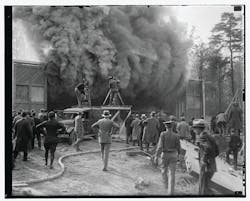CHARLOTTE, NC: JULY 1, 1914 – The Charlotte Fire Department responded to a barn fire behind the home of a railway contractor. Unknown to the firemen, the contractor had dynamite stored in the barn. As a hoseline was being stretched in and the attack was begun, the dynamite suddenly exploded. Captain W.B. Glenn was killed instantly. Chief J. Harvey Wallace was critically injured and died in the hospital. Three other firemen were also injured.
SOUTH NORWALK, CT: JULY 3, 1914 – Fire swept through the Hatch & Bailey lumber yards and extending to the railroad bridge of the New York, New Haven & Hartford Railroad. The bridge was partially destroyed and disrupted train service for several days. The blaze also threatened several nearby plants and factories, but firemen saved the buildings.
NEW YORK CITY: JULY 12, 1914 – Two men were returning home in their motorboat after a two-week trip up the Hudson River. As they were making their last turn before docking in the ship canal at the Spuyten Duyvil (Dutch for Spouting Devil, for the dangerous waters where the Harlem and Hudson rivers converge), gasoline in the boat exploded and the boat caught fire. The men sounded a distress whistle that was answered by a tugboat, a fireboat and a police launch. They donned life jackets and jumped overboard as the Fireboat George B. McClellan moved in, dousing the flames with its deck monitor. The men were safely pulled onboard the police launch.
ST. PETERSBURG, RUSSIA: July 15, 1914 – As Europe politically bubbled just prior to the start of World War 1 (Archduke Franz Ferdinand, the heir to the Austro-Hungarian throne, was assassinated on June 28, 1914), workers in Russia began a general strike. Many days of protest and rioting led to a huge fire that swept a portion of the city. More than 25 houses were consumed by a conflagration that roared through the workers district.
JASONVILLE, IN: JULY 25, 1914 – A fire that apparently started in the Family Theatre on Main Street spread quickly to a grocery store and was soon extending both east and western before jumping the street. Firemen were faced with a wall of fire that was consuming everything in its path. Dynamite was used to provide a firebreak as a valiant stand was made. Backed up by firemen from Terre Haute, they tried to stop the extension, but a lack of water limited their effectiveness. Six businesses and two residential blocks were destroyed and one man was killed.
GLOVERSVILLE, NY: JULY 26, 1914 – A plant that manufactured woolen goods was destroyed by an afternoon fire. The plant was just outside city limits and no firefighting force was available. The wind carried burning embers a mile away a set fire to a large barn, burning 50 tons of hay and several valuable horses.
LOUISVILLE, KY: JULY 27, 1914 – Flames broke out in the sheep pens of a large stockyard and spread to a nearby railroad station. Every piece of firefighting equipment rolled in as the fire leaped from the sheep and hog pens to several railcars. One car, loaded with oil, exploded. The burning liquid then ignited several homes. Firemen scrambled to stop the spreading flames and finally saved portions of the stock yard.
SEATTLE, WA: JULY 30, 1914 – Around 3:40 in the afternoon, wisps of smoke were seen at the south side of the Grand Trunk Pacific Dock at the foot of Warren Street. This pier complex was, at the time, the largest wooden pier on the West Coast. Cries of “Fire!” brought the immediate response of Engine 5, stationed next door. As the firemen investigated the growing smoke condition seeping up through the floorboards and a first alarm was transmitted, an apparent flashover occurred. The four-year-old dock was suddenly a mass of flames as 3.7 million board feet of lumber and 5,000 creosoted pilings burned with a fury. While firemen battled the flames inside the pier structure, the fire engine’s gasoline tank ignited. Ten firemen were injured; several were seriously burned, including Fireman Patrick Cooper, who died three days later. Four civilians were also killed and 19 were injured. Land-based fire companies and fireboats battled the huge fire throughout the afternoon.
About the Author
Paul Hashagen
PAUL HASHAGEN, a Firehouse® contributing editor, is a retired FDNY firefighter who was assigned to Rescue 1 in Manhattan. He is also an ex-chief of the Freeport, NY, Fire Department. Hashagen is the author of FDNY: The Bravest, An Illustrated History 1865-2002, the official history of the New York City Fire Department, and other fire service books.
Connect with Paul
Website: paulhashagen.com
Facebook: Paul Hashagen-author
